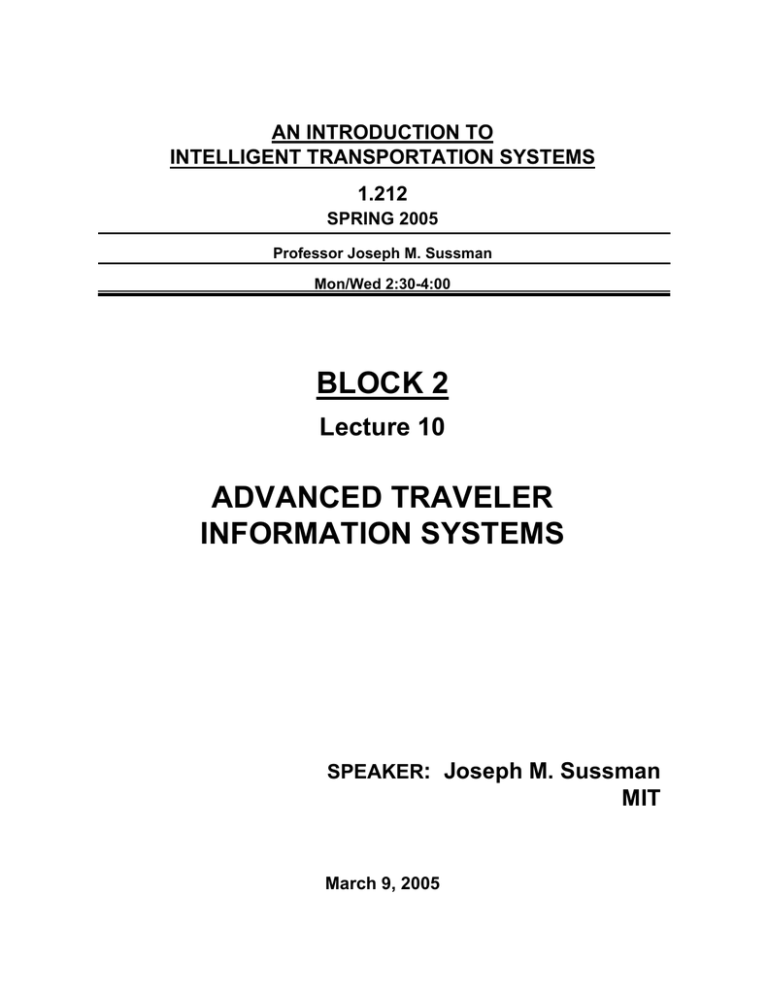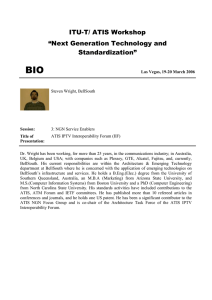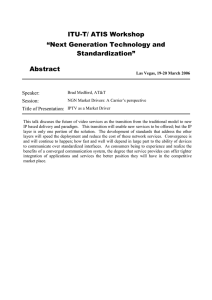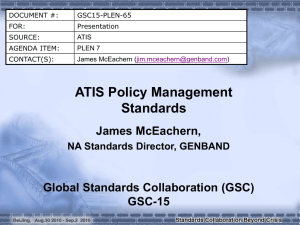BLOCK 2 ADVANCED TRAVELER INFORMATION SYSTEMS Lecture 10
advertisement

AN INTRODUCTION TO INTELLIGENT TRANSPORTATION SYSTEMS 1.212 SPRING 2005 Professor Joseph M. Sussman Mon/Wed 2:30-4:00 BLOCK 2 Lecture 10 ADVANCED TRAVELER INFORMATION SYSTEMS SPEAKER: Joseph M. Sussman MIT March 9, 2005 FREIGHT RELIABILITY DRIVEN BY INVENTORY AND STOCK-OUTS WHAT CAN GO WRONG? Delays along the way -- service reliability Inventory at B 80 40 1 ISSUE: Stock-outs 2 3 goods don’t arrive Time WHAT CAN GO WRONG? (CONTINUED) So, perhaps the customer at B keeps a day’s worth of inventory Inventory 80 1 Problems: 2 3 Bigger Inventory Warehousing Costs Insurance Costs 4 Time (days) A BIG ISSUE -- STOCKOUTS WHAT DOES A STOCK-OUT COST? Examples GM Assembly Plant Retail Store Blood Bank INVENTORY MINIMIZATION If one needs a greater amount of inventory because of unreliability in the transportation system or probabilistic use rate, you generate costs as a result of needing larger inventory to avoid stock-outs. We try to balance the costs of additional inventory with the costs of stock-outs. TOTAL LOGISTICS COSTS (TLC) Total Logistics Costs (TLC) = f (travel time distribution, inventory costs, stock-out costs, ordering costs, value of commodity, transportation rate, etc.) TRAVEL TIME DISTRIBUTION FROM SHIPPER TO RECEIVER f(t) t Figure 12.14 This probability density function defines how reliable a particular mode is. TLC is a function of the travel time distribution. As the average travel time and variance grows, larger inventories are needed. TRAVELER RELIABILITY NOW IT IS TIME UTILIZATION AND NOT INVENTORY WE ARE CONCERNED WITH How can you deal with uncertainty in travel times? Choose time when conditions are stable Choose routes with stable conditions Choose routes you know Build knowledge through experiment Minimize consequences through safety margins Get better information before the trip or en route Bonsall, Peter, “Travellers’ Response to Uncertainty”, Chapter 1 in Reliability of Transport Networks, Bell and Cassir, eds., Research Studies Press Ltd., Baldock, Hertfordshire, England, 2000. 80 min (50%), 60 min (50%) 70 min (100%) A B Risk Averse Risk Neutral Risk Prone Bottom Either Top Think we should design unreliable systems for the thrill-seekers? Yin, Yafeng and Hitoshi Ieda, “Assessing Performance Reliability of Road Networks Under Nonrecurrent Congestion”, Transportation Research Record 1771, National Academy Press, Washington, DC. Desired Arrival Time = 9 am f (tt) for departure times from 7:30-8:30am 1 hr tt What is the overall travel time distribution composed of? f (tt) tt Light Day Regular Day Terrible Day -Big Crash With no traveler information, how would you decide when to leave? 9 am Utility of Arrival OR 9 am Utility of Arrival Suppose at 7:30, while still at home, you can find out what kind of a day it is Light Regular Terrible What do you do, based on that information? So, do you really save actual traffic time? Maybe a little, but not much. Does that mean there is no value to ATIS? ATIS Non-User: Travel Times Based on Past Experience 22 min Trip Start: 8:05 am 20 min 27 min alternative route 25 min Expected Arrival: 8:50 am On-Time Target: 9:00 am habitual route selected Figure ES-1: ATIS Non-User Route Choice and Trip Timing ATIS User: Reported Travel Times at 8 am 31 min 24 min alternative route selected Trip Start: 8:00 am 27 min 35 min Expected Arrival: 8:55 am Target Arrival: 9:00 am habitual route Figure ES-2: ATIS User Route Choice and Trip Timing Wunderlich, Karl, Matthew Hardy, James Larkin, Vaishali Shah, “On-Time Reliability Impacts of Advanced Traveler Information Services (ATIS): Washington, DC Case Study”, Mitretek Systems, McLean, VA, January 2001. MITRETEK CONCLUSIONS ATIS benefits are grossly understated if only travel time savings are included. The value of improved on-time reliability is not easily nor directly monitized, but it is clear that many types of travelers can benefit from ATIS. Trucks delivering auto parts in a just-in-time manufacturing process may highly value any improvement in on-time reliability or reduction in early schedule delay. Commuters face an on-time requirement not only on the home-to-work leg of their daily trip-making, but increasingly on the work-to-home return trip in order to meet daycare pickup requirements and other commitments. Improved reliability and predictability of travel are also likely good surrogates for reduced commuter stress. Wunderlich, Karl, Matthew Hardy, James Larkin, Vaishali Shah, “On-Time Reliability Impacts of Advanced Traveler Information Services (ATIS): Washington, DC Case Study”, Mitretek Systems, McLean, VA, January 2001. MITRETEK CONCLUSIONS (2) Overall, ATIS use proved advantageous in efficiently managing the traveler’s time. Specific quantitative examples selected from the Washington, DC, case study include: Peak-period commuters who do not use ATIS were three to six times more likely to arrive late compared to counterparts who use ATIS; Cases where ATIS clearly benefits the user (e.g., ATIS user on-time, non-user late) outweighed cases where ATIS clearly disadvantages the user by five to one; ATIS users in peak periods are more frequently on-time than conservative non-users, yet they experience only two-thirds as much early schedule delay as non-users; Late shock, the surprise of arriving late, is reduced by 81% through ATIS use. Wunderlich, Karl, Matthew Hardy, James Larkin, Vaishali Shah, “On-Time Reliability Impacts of Advanced Traveler Information Services (ATIS): Washington, DC Case Study”, Mitretek Systems, McLean, VA, January 2001. Llaneras, Robert E. and Neil D. Lerner, “The Effects of ATIS on Driver Decision Making”, ITS Quarterly, Washington, DC, Summer 2000. Simulation Approach 72 drivers Ages 18-86 Equal number of males and females Familiarity with actual roads (but this was a simulation) THREE LEVELS OF ATIS No ATIS Basic ATIS Descriptive information about incidents and congestion Location, type of incident Enhanced ATIS Basic plus the following Alternative route Incident details Real-time traffic map Live video traffic images TWO TRAFFIC LEVELS Light Moderately Heavy So, Six Experimental Conditions, Twelve Participants per Condition Also, incidents built into the simulations CONCLUSION ATIS influences en route driver decisionmaking Drivers will divert Travel time savings occurred as a function of ATIS features Some drivers did worse by diverting Travel level (light vs. moderately heavy) had little effect on driver behavior Maps work SOME QUESTIONS Can you separate traffic management and traveler information? Does it make sense to have one without the other? Reporting traffic conditions without doing anything about it. Can the for-profit sector compete with people giving away information (radio stations, e.g.)? Is there value-added for better information? Do customers act on it? QUESTIONS/ISSUES Value of information -- how to measure? Price -- will people pay? Costs (and who bears them) Quality of information and how to assure “Ethics” -- just because you can pay, should you be advantaged in using a public facility? Safety -- distraction Privacy Providing people “wrong” information to enhance overall flows. Does ATIS help or hurt congestion -network operations? STATIC INFORMATION (E.G., NETWORK TOPOGRAPHY) SEMIDYNAMIC INFORMATION (E.G., CONSTRUCTION) DYNAMIC INFORMATION “E”-INFORMATION FROM ATMS FIELD IN REAL-TIME --------ESTIMATE NETWORK STATE E.G., VOLUMES SPEEDS QUEUES NON-“E”-INFORMATION E.G., SPOTTER AIRCRAFT STATE POLICE GENERATE NETWORK STRATEGIES ATIS --------INFORMATION TO TRAVELERS E.G., DYNAMIC ROUTING PREDICTION OF FUTURE NETWORK STATE AS F (STRATEGY) INCLUDING “GUESSES” INFORMATION TO INDIVIDUAL VEHICLES E.G., VARIABLE MESSAGE SIGNS ABOUT TRAVELER REACTION TO ATIS ACTUAL CHANGE IN TRAVELER BEHAVIOR? SELECT AND DEPLOY STRATEGY WRAP-UP ITS provides substantial data gathering capability Static Semi-dynamic Dynamic Can this data be translated into information of value? To individual travelers To network operators Are there interests of individual travelers and network operators complimentary or antithetic? Can we make good (consistent) predictions of the future state of the network if people act on traveler information? Can ATIS be a business? Can it create customers? (Peter Drucker)


